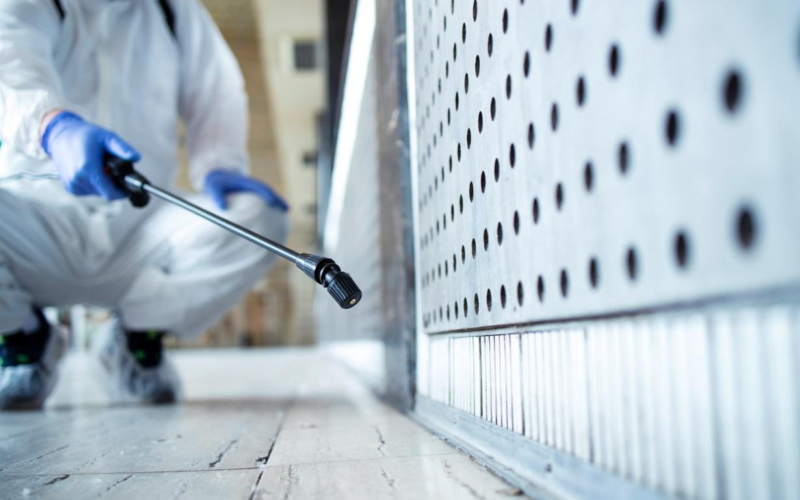What is Pest Control?
Pest control refers to the management or elimination of pests, which are organisms that can be harmful, disruptive, and a nuisance to humans, animals, and the environment. Pest control measures are applied to prevent the damage caused by pests and to protect property, crops, and public health.

Integrated Pest Management
Integrated Pest Management (IPM) is an approach that combines multiple methods to manage pests in a sustainable and environment-friendly way. It emphasizes the use of various techniques while minimizing the use of chemical pesticides.
Pest management or control is crucial in agriculture to protect crops, in homes and businesses to prevent property damage and ensure health and safety, and in public health to prevent the spread of diseases carried by pests. Professional pest control services are often employed to assess, monitor, and implement effective pest management strategies.

Why is Pest Control a necessity?
Pest Management is essential for several reasons, and its importance extends to various aspects of human life, agriculture, and public health. Here are some key reasons why pest control is necessary:
1. Protection of Agriculture:
Pests, such as insects, rodents, and pathogens, can cause substantial damage to crops. They may eat or damage plants, reducing agricultural yields and affecting food production. Pest control helps safeguard crops and ensures a stable and reliable food supply.
2. Prevention of Property Damage:
Pests can damage buildings, furniture, and other household items. Termites, rodents, and insects, for example, can cause structural damage to buildings and houses. Effective pest control helps prevent such damage and preserves buildings and its infrastructure.
3. Public Health Concerns:
Some pests are carriers for diseases that can affect humans, animals, and crops. Controlling pests is crucial to prevent the spread of diseases like malaria (transmitted by mosquitoes), Lyme disease (transmitted by ticks), and numerous foodborne illnesses triggered by pests contaminating food.
4. Environmental Protection:
The use of pesticides in pest control requires careful consideration to minimize environmental impact. However, allowing unchecked pest populations can lead to ecological imbalances and harm other non-target species. Integrated Pest Management (IPM) approaches aim to reduce environmental impact while effectively managing pest populations.
5. Preservation of Biodiversity:
Pests can disrupt ecosystems and contribute to the decline of native species. Invasive species, in particular, can outcompete or prey on native organisms, leading to biodiversity loss. Proper pest control measures can help mitigate these impacts and protect native flora and fauna.
6. Economic Considerations:
Pest infestations can have significant economic consequences. Crop losses, property damage, and expenses related to healthcare and pest management can result in financial burdens. Pest control helps minimize these economic impacts and supports sustainable development.
7. Quality of Life:
Pests can be a nuisance in residential, commercial, and public spaces, affecting the quality of life for people. Infestations of insects, rodents, or other pests can lead to discomfort, stress, and potential health issues. Pest control measures aim to create healthier and more comfortable living environments.
In summary, pest management or control is crucial for maintaining a balance in ecosystems, protecting agriculture, preventing property damage, ensuring public health, and preserving biodiversity. Implementing responsible and sustainable pest control practices is essential to address these diverse challenges effectively.
What are the different kinds of pests affecting our homes and offices that need pest control methods?
Pests are unwanted organisms that can invade homes, causing damage, posing health risks, and creating general nuisance. The types of pests found in residential or even commercial areas can vary based on geographic location, climate, and living conditions. Some of the most common pests include:
1. Insects
- Ants: Certain ant species may invade homes in search of food.
- Cockroaches: These insects can contaminate food and trigger allergies.
- Termites: Known for causing structural damage to wood.
- Bed Bugs: Parasitic insects that feed on human blood, usually found in bedding and furniture.
- Fleas and Ticks: Common in homes with pets, these pests can also bite humans.
- Spiders: While most are harmless, some spider bites can cause discomfort.
2. Rodents
- Rats and Mice: These pests can contaminate food, damage property, and transmit diseases.
3. Nuisance Wildlife:
- Raccoons, Squirrels, Skunks, and Possums: These animals can invade attics, garages, or yards in search of food and shelter.
4. Stinging Insects:
- Wasps, Bees, and Hornets: Nests built near or inside homes can pose a threat, especially to individuals allergic to stings.
5. Mosquitoes:
- These insects can be a nuisance and may transmit diseases.
6. Bedroom Pests:
- Dust Mites: Microscopic pests that can trigger allergies.
- Lice: Parasitic insects that infest the scalp and body.
7. Crawling Insects:
- Silverfish, Earwigs, and Centipedes: These pests are often found in damp or dark areas of the home.
8. Birds and Bats:
- Pigeons, Starlings, and Bats: When they roost in or around homes, they can cause damage and health concerns.
9. Carpenter Bees and Carpenter Ants:
- These pests can damage wood structures in and around homes.
10. Stored Product Pests:
- Pantry Moths and Beetles: These pests infest stored food products.
Proper sanitation, sealing entry points, and regular maintenance can help prevent and control residential pest infestations. If a pest issue becomes severe, homeowners should seek professional pest control services to address the problem effectively and safely.
Types of Pest Control
There are various types of pest control treatments available, each tailored to target specific pests and situations. Here are some common methods:
Let’s discuss each type of Pest Control method one by one.
| Chemical : | 1. Insecticides: Chemicals designed to kill or repel insects 2. Rodenticides: Used to control rodent populations 3. Herbicides: Control unwanted vegetation |
| Biological: | 1. Predators and Parasites: Introducing natural enemies of pests to control their populations. 2. Microbial Pest Control: Using bacteria, fungi, or viruses to target specific pests. |
| Physical/Mechanical: | 1. Traps and Baits: Devices designed to capture or kill pests. 2. Barriers: Creating physical barriers to prevent pest entry. |
| Cultural: | 1. Crop Rotation: Changing the planting location to disrupt pest life cycles. 2. Proper Waste Management: Removing potential pest habitats. |
| Natural/Organic: | 1. Neem Oil, Diatomaceous Earth: Natural substances that can control pests. 2. Biological Pesticides: Pesticides derived from natural materials. |
| Genetic: | 1.Sterile Insect Technique (SIT): Releasing sterile male insects to reduce reproduction rates. |
| IPM: | 1. Combining various methods: IPM (Integrated Pest Management) involves using multiple strategies to control pests in a sustainable and environmentally friendly way. |
| Ultrasonic Devices: | 1. Emits high-frequency sound waves: Some devices claim to repel pests using ultrasonic sound. |
| Heat Treatment: | 1. Used for bed bugs and termites: Raising temperatures to levels that are lethal to the pests. |
| Fumigation: | 1. Gas-based treatment: Used to control pests in confined spaces. |
It’s important to note that the choice of pest control method depends on factors such as the type of pest, severity of the infestation, environmental considerations, and potential impact on non-target organisms. Professional pest control services often assess the situation and recommend a combination of these methods for effective and sustainable pest management.
Read Similar Articles: How Much time does it take to get rid of pests?
